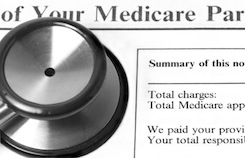Learn more about Medicare Part D and whether you should enroll.
Everyone with Medicare has access to its prescription drug coverage, called Medicare Part D . Enrolling is optional. Here are some things to consider when deciding if Medicare Part D is right for you.
Am I eligible for Medicare Part D?
If you are eligible for Medicare , then you are eligible for Medicare Part D.
Should I enroll in Medicare Part D?
Whether or not you should enroll depends on how you pay for your prescription drugs now, or plan to in the future. Review these four scenarios to see if one applies to your situation:
- You have Medicaid. In this case, if you are eligible for Medicare, you will automatically be signed up for Medicare Part D. (Although you will be placed in a plan at random.)
- You have a Medicare Advantage Plan. Many Advantage Plans (also known as Medicare Part C) offer Medicare prescription drug coverage. Call your plan to find out if yours does.
- You have an employer or union insurance plan. First, find out if your insurance plan will continue through your employer once you turn 65 or retire. If not, you’ll need another way to pay for your prescription drugs. If your coverage will continue, call your plan to find out if its prescription drug coverage is as good as Medicare Part D coverage, and talk with your employer or union benefits department to make an informed choice.
- You have a s upplemental insurance plan or Medigap. Most Medigap and supplemental insurance plans don’t cover prescription drug costs. Contact your plan to find out what coverage may be available to you.
How much will Medicare Part D cost?
Unless you qualify for reduced or no-cost coverage, you will need to pay monthly premiums, deductibles, copayments (or coinsurance), and all costs associated with the Medicare coverage gap (also known as the “donut hole”).
On average, those with Medicare Part D can expect to pay nearly $41 in monthly premiums in 2011. These costs vary depending on the plan you choose and where you live. The amount of your deductible and copayment will also vary depending on the plan you choose. (The maximum deductible for 2011 is $310.)
How much will I pay for the “donut hole?”
The donut hole is the amount you’ll need to pay out of pocket from the time you reach your initial coverage limit to the point when catastrophic coverage kicks in. The good news is that the hole is beginning to close, and will be completely closed by 2020. In 2011, once you have reached $2,840 in your Medicare Part D coverage, you’ll need to pay 50 percent (versus 100 percent) of your brand-name drug costs (7 percent for generics) until you hit $4,550, at which point catastrophic coverage begins.
When can I enroll?
If you are turning 65 soon, you can enroll up to three months before or three months after your birthday. If you currently have a Medicare Part D plan and wish to switch plans, you may do so during the enrollment period, which goes from November 15 through December 31 each year.
It’s important to keep in mind that if you are eligible for Medicare Part D and choose not to enroll at that time, but wish to at a later date, you will be charged a penalty. The penalty will increase your monthly premium by 1 percent and will continue to be charged for the rest of the time you maintain Medicare Part D coverage.
How do I enroll?
If you wish to enroll in Medicare Part D, you’ll first need to pick a plan that will best fit your prescription medication needs. Then you can enroll by contacting the plan of your choice directly or by contacting Medicare—both accept enrollments over the phone or online.
Where can I get help?
If you’re still not sure if Medicare Part D insurance is something you need, talk with professional. You can speak with a State Health Insurance Assistance Program (SHIP) counselor in your county, or contact Medicare directly for assistance.
This article contains general information. Consult your financial or Medicare advisor before utilizing any of the information contained in this article.
Related Articles
- Pick The Medicare Part D Plan That's Right For You!
- Prescription Insurance
- Medicare Supplement Changes for 2010
- Why You Need A Personal Health Record
- Affordable health insurance: How to save on your health-care costs
- Purchasing Individual Health Insurance: What you need to know
- HMO Insurance
- Do You Need Long Term Care Insurance?
- Why You Need Long Term Disability Insurance
- Medicare Prescription Drug Coverage
- Medigap Supplemental Insurance Explained
- Supplemental Insurance - What Is It?
- Medical Marijuana - Should Marijuana Be a Medical Option?
- Prescription Drugs - Should They Be Advertised to Consumers?
- Pet Insurance: Do You Need It?















